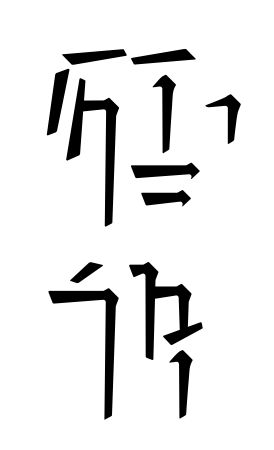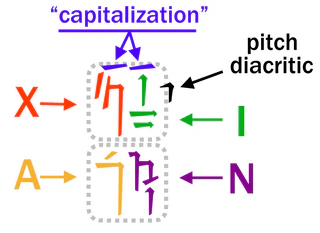
The Xi'an language ( Xi'an: uoa29xyan2 (Proper); ) is the language spoken by the Xi'an across the Xi'an Empire. It is the first Alien language of the Star Citizen Universe released to the public. It will be fully integrated in the game - though the implications on the gameplay side are uncertain for the moment. Developed by conlang artist Britton Watkins and the CIG writing team for Star Citizen and Squadron 42, it is intended to be further expanded together with the community via special Xi'an language sites on the RSI website.
Introduction
The Xi'an and their culture are initially based on Han dynasty China (around 206 BCE – 220 CE), so their language is influenced by various Asian languages - both in writing and pronunciation.[1] They live for hundreds of years and plan for decades rather than years, and often they come across rather reserved. This restrained and diplomatic demeanor also carries over into their language and speech. Getting the correct tone of politeness can be difficult for non-native speakers.
Important features
- 'Verticality', meaning that writing is usually from top to bottom and right to left (but can theoretically be written in any direction)
- Tonal:
- Long and short vowel distinction
- Pitch is important - syllables may have a higher, neutral or lower tone - usually indicated by '' and .'
- Various dialects, but most important are the so-called Proper Xi'an (uo'a e thle'a) and Service Dialect (uo'a se Hyath)
- 200 different letters or "glyphs", written in blocks to form words
- Only 9 verbs, but depending on 'politeness' or 'flavour' they are written differently
As stated above, the distinction into various levels of politeness is very important in the Xi'an language and is difficult to see or hear for non-native speakers. Being overly polite can be as bad as it is to be excessively casual. The right balance is important and not always easy.
Dialects
Because of the large size of the Xi'an Empire, there are numerous dialects and languages spoken across their empire.[2]
Proper Xi'an
Proper Xi'an or Proper language ( Xi'an: uoa2 e thlea2 (Proper); literally proper speech; ) is the standard dialect of the Xi'an language.[2]
Service dialect
Service dialect or Military dialect ( Xi'an: uoa2 se 9hyath (Proper); literally military speech; ) is a common dialect of the Xi'an language. It is common among those who are in or served in the Xi'an Defense Forces. It is a multi-millennia-old remnant of the military-centric unification of their empire by the Ru'a Dynasty in the dawn of the First Imperial Age.[2]
Provincial dialects
There are provincial dialects that varies across regions from regions.
Writing
Alphabets

The Xi'an alphabet ( Xi'an: kyexiin (Proper); literally script / alphabetic letter; ) is based on around 200 glyphs that developed out of the Xi'an way to write in very specific blocks. Depending on whether the glyph is written in the whole block, half of the block or only one corner (usually upper right or lower right), three groups of glyphs can be distinguished:
- basic
- block
- corner
This is a very efficient way to get as much phonetic information in one block as possible, but can also lead to more difficult to read glyphs, especially for corner diphthongs. Additionally, there exist various pitch diacritics to mark pitches on specific syllables - from low or high to falling or rising pitch.

There exist many different styles of writing Xi'an, but the most important ones are xiinthle'a and Standard Romanized Xi'an (SRX), which was developed to transscribe Xi'an into easier readable Roman letters.[2]
Proper writing
Proper writing ( Xi'an: xiinthlea2 (Proper); literally proper writing; ) is a Xi'an language typeset of Xi'an alphabet. It is considered quite proper by the Xi'an and it is common in Xi'an Empire. It is almost always written vertically from the upper right flowing to the lower left. It does occur horizontally in special circumstances.[2]
Standard Romanized Xi'an
A standardized system of writing Xi'an in Roman letters was developed in the so-called SRX. It introduces .' and '' as equivalents to the pitch markers in kyexiin and rules for translating Xi'an writings. Long vowels are marked by macrons (ā, ē, ō, ū) and a double i (ii) are another disctinct feature of Xi'an as is the pronounciation of the diphthongs created with u (ua, ue, ui, uo). These are spoken like a W as wah, weh, woh, wuh and wee.[2]
Sounds
Anatomically the Xi'an are still similar enough to humans that they have no difficult or even impossible sounds in their language. The most important thing to be aware here is the pitch, meaning the tone of certain syllables in words. For example a falling pitch in the word lo'a gives us the word nine (9), while a neutral tone loa leads to the word for eat or drink.
Example - pitch in numbers 0 to 10:
Verbs & sentences

There exist only 6 verbs in Xi'an. These do not conjugate (meaning their ending does not change form), but they have different forms depending on politeness levels.
Usual word order in sentences is VSO - verb subject object.[2]
Influences
´
"It's not based specifically on a any single human language. There are many ideas (...) especially the phonology that comes from asia, that are inspired directly or indirectly by a kind of mashup of what happens with the pitch and tone in Japanese and Thai and Chinese. There are some grammatical structures...I mean even the way some verbs works where there's a verb and then you put a content word after it in order to make it mean a broader meaning. There are several human languages that do that."
Britton Watkins - Happy Hour Interview: The Xi'an Language and YOU
Useful links
Resources
- Useful learning resources
- Quick Guide
- Xi'an Alphabet
- Dictionary
- Gameplay terms
- Human names in Xi'an
- Naming Xi'an animals
Video lessons
- uo'aXy'an Lesson One: Introduction and Greetings
- uo'aXy'an Lesson Two: Pronunciation and Writing
- uo'aXy'an Lesson Three: Useful Phrases and Aural Distinction
- uo'aXy'an Lesson Four: Verbs and Word Order
- uo'aXy'an Lesson Five: Politeness, Verbs, and Pronouns
Spectrum threads
Additional links
- Happy Hour Interview (video): The Xi'an Language and YOU
- Community Contest (closed): Naming Animals from the Xi'an Empire
Community tools